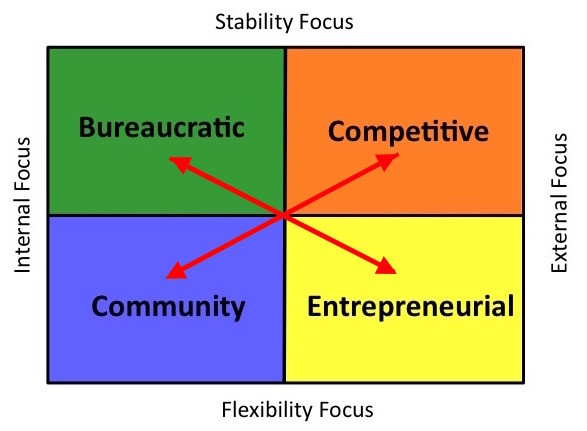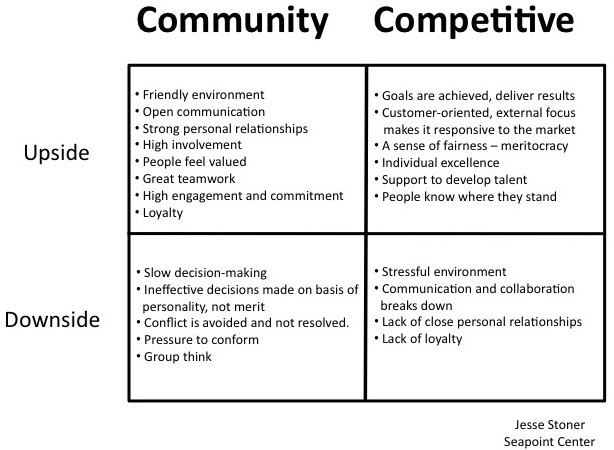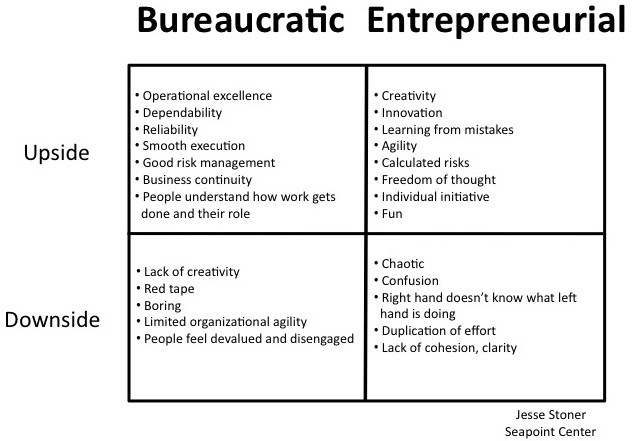Too much of a good thing brings out its downside. Ever had too much team time? It makes you long for a solo vacation on a desert island.
One of the best portrayals of “too much of a good thing” was in Black Mirror’s Nose Dive (Season 3). In what initially looks like a utopian culture where everyone is always happy, people use an app to rate each other on the quality of their interactions. The more points you get, the higher your socioeconomic status. But the underside of too much pleasantness is insincerity. After a series of miserable mishaps, a perky young woman is unable to maintain the facade. It ends with her in prison, having lost all her points, quite happily trading insults with another prisoner.
There is an upside and downside for each type of organizational culture. Some people think one type of culture is better than others. But overemphasis brings out the downside of any culture, as Nose Dive demonstrated.
The upside of a collaborative culture is the ability to achieve greater heights – the whole is greater than the sum of its parts. But too much collaboration and you end up with group think. The upside of a competitive culture is individual excellence and delivering results that meet customer needs, but the downside is burnout and stress.
A bureaucratic culture’s upside is operational excellence. But if it’s overdone, you get bogged down in red tape. The upside of an entrepreneurial culture is flexibility and creativity. The downside is chaos.
Organizational Culture Polarities
Each of the four types of organizational culture can be seen as a polarity in relation to its opposite type – its diagonal on the diagram below:

These polarities are opposites on both the Internal:External dimension and the Change:Stability dimension. If your culture is primarily Community, the diagonal is Competitive. The diagonal of Bureaucratic is Entrepreneurial.
It’s a mistake to dismiss the polarity of your organization’s culture (ex. assuming collaborative is better than competitive). Instead, find ways to incorporate some of its upside to avoid ending up with “too much of a good thing.” This is the key to maintaining a strong, healthy culture. If you find you’re hanging out more in the downside of your culture type, you can tweak it by taking a close look at your policies, procedures, structures, and reward systems, providing communications to change mindsets, and changing your own behavior as a leader.
The Upside and the Downside
Barry Johnson developed a way of mapping polarities to understand the upside and the downside of each pole. Each of the culture type diagonals are mapped below. Locate your organization’s primary culture type (Community, Competitive, Bureaucratic or Entrepreneurial) and then consider how much your organization’s culture resides in the upside. Do you see evidence of the downside at play? If so, take a look at the upside of its opposite. As you can see on diagram, the remedy to the downside of each side lies in the upside of its polarity.















Brilliant! I’m a team leader and don’t have much influence on my company’s culture, but I can see how this applies to teams as well. The agenda for our next team meeting is going to be what kind of culture do we think we have, what do we think we need and what needs to change. Your polarity diagrams will be a big help. Thank you!
Thanks for pointing out that it is possible to apply these ideas to a team. Your ideas for a team meeting are spot on. It is possible for a team to create its own microclimate. Good luck, Greg!
Your last two articles have been extremely useful. I am researching why many people do not want to compete and specifically how to motivate people that are non-competitive – a concept personally foreign to me. The Upside/Downside view presented in this article is particularly helpful to me in understanding that VALUES are probably the primary culture drivers. Thanks for your help.
Yes, values are the primary culture driver – for organizations and for people. For more information on personal preferences around competing, I suggest you take a look at the work of Ken Thomas and Ralph Kilmann who identified five conflict styles. Each has its own upside and downside.
This is a powerful model, and I love it! These culture types are based on the Competing Values Framework, developed by Kim Cameron and Robert Quinn. The names displayed here are different, but the characteristics are the same. You can test where you’re currently at with Cameron and Quinn’s OCAI survey. The Framework is powerful because it helps people balance competitive values and skills that you need to be successful, both as a person and as an organization.
Thanks Marcella. The OCAI looks like an excellent culture assessment tool. This model is based on the two variables (competing values) identified by Quinn & Rohrbaugh in 1983. For more information, my earlier post Four Types of Organizational Culture provides an overview of the model and includes a link to their research and work. p.s. Congrats on the upcoming release of your new book Developing a Positive Culture where People and Performance Thrive.
This is an amazing piece, Jesse. I will save it for future use. As a retiree, I’m sending it to my ministers and church board president!
So glad to hear you found it useful and are sharing it Marye Gail.
As most complex things in life it is not a matter of either or, but finding balance in the priorities. This sequel to your first blog of four types of culture is a great addition. CEOs and leaders at all levels should consider the pros and cons of their current culture and what needs adjustment to support changing strategies.
Agree. The challenge is to identify the right polarities. Many thanks for sharing your insights, Jeannie!
More up to date info on polarity thinking and mapping is available at http://www.polaritypartnerships.com! The infinity loop highlighting the energy dynamic is an important evolution of the theory, as is the ability to measure performance in multiple polarity tensions for: leaders, teams, organizations, communities, and national/global systems.
May I be so bold as to suggest using the Polarity Map? It helps appreciate the many decades of evolution of the theory and helps it to not be confused with a 2×2 matrix.
The infinity loop helps people appreciate the dynamic energy in the tension and ability to maximize upside benefits and minimize downside limitations (leverage=better than balance)
Thanks Cliff. I did provide a link to Barry Johnson’s work and how to create a polarity map in the article. Polarity Partnerships has developed an excellent assessment. All good stuff. Thanks for the recommendations.
Jesse, this is great. Thanks. I think that a Competitive Collaborative culture is necessary. Areas of influence collaborating with the success of the business being the goal, not individual or unit success. That’s where the competition comes in.
Many thanks for your thoughts Ken! It’s hard to imagine an organization being successful without a bit of each of the 4 culture types. Customer-focus and drive for results are important. However, a competitive culture is not always the best dominant culture. My article the 4 Types of Organizational Culture discusses how the best type of culture depends on the business strategies and goals.
Terrific model that pulls so much together. I would wonder about making it sound like team and collaboration are practically synonyms. I think that we move from group to team to high performance team to collaborators. Collaborators are different on a number of dimensions, mainly to the degree which they are disruptors, committed to the purpose(s), and completely uninhibited by boundaries.
Please read my blog on collaborators which will be out by the end of next week.
Interesting thoughts, Bob. Thanks for sharing them. I’d like to invite you to share the link to your blog.
Not sure I’ve seen this previously. I’d offer two thoughts:
1. If we interpret ‘organizational’ as taking charge of the various aspects of addressing the mission statement aligned with associated values, this graphic and associated tables apply equally well to individuals exerting what I’ve labeled Personal Servant Leadership (#PSL on ‘X’). And yes, individuals have communities – just all informal cooperation.
2. Whether applied to individuals or actual organizations, I will suggest that the sweet spot is near the center of the graphic where the two diagonals cross. Specific opportunities will likely require emphasis on one or two of the cultures but most every opportunity will require some input from all four.
John, That’s an interesting premise that this could apply to individuals as well. Makes sense. I agree that the sweet spot might be in the middle, but I’m not sure it could be maintained. You might enjoy my post: Manage Your Polarities or They Will Manage You
I am fascinated by “too much of a good thing”. Had never quite considered that the parity could very well be greatly needed.. much like Situational Leadership depends upon the situation and the follower. For example, right now in this nation we truly need community culture combined with a competitive culture to get things done–in a way that support the whole and not the few.
Just love your work and your brain!
Thanks Eileen, It’s counter-intuitive to look to the opposite of the culture type for clues on how to improve it when things get stuck. I agree with Cliff that this is where Barry Johnson’s work on polarity thinking is really helpful.
Oh this is so wise and vividly so in its specificity that enables you to offer actionable insights (again) Jesse Lyn Stoner
Delighted to hear that, Kare. Clear and actionable is my goal. Many thanks for taking the time to comment.